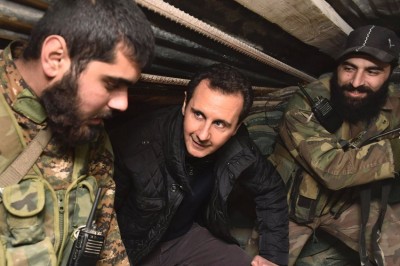
Substantial territorial losses by the regime in the northern city of Jisr-el-Shugur and beyond, after the city of Idlib also fell to rebels, coupled with a relatively successful series of advances around the southwest of Damascus, are the result of new levels of cooperation among rebel groups that have spent the past years fighting each other for supremacy, to the detriment of their campaign against al-Assad. The rise of ISIS had also provided another obstacle to more moderate rebels in their fight against the Syrian regime.
Rebels are making advances in key cities like the coastal supply town of Latakia and the strategic city of Aleppo.
This change may more broadly assist U.S. foreign policy goals by raising the likelihood of the al-Assad regime — or those within it — being willing to contemplate a political solution to the now four-year war. Yet it comes with a substantial downside: Many of the rebel groups seeing success now are allied with and fighting alongside the Nusra Front — al Qaeda’s franchise in Syria.
The rebel storming of Jisr-el-Shugur in late April provided many analysts with evidence the rebels’ recent success in taking Idlib was part of a broader improvement in strategy. The same rebels now film themselves with heavy weapons in what appear to be the mountains between Jisr el-Shugur and the coastal city of Latakia, a port of great strategic significance for both sides which the rebels now have in their sights.
The change in territorial control does leave the rebels potentially with a larger swath of northern Syria more firmly under their control and, if sustained, will eventually pressure the parts of Syria’s largest city, Aleppo, that the regime still holds. Rebels can now also project force southward down the main highway toward Hama, challenging the key roads that are the vital supply channels in this war of attrition.
Around Damascus, the regime is in a better position but has seen significant losses to the south. Rebels took a key border crossing with Jordan recently and have since been reported to have made gains to the southwest of the capital.
Analysts put this change in the dynamics down to both cooperation between rebel groups who once fought each other and also greater coordination between their Sunni and Gulf backers — Qatar, Saudi Arabia and Turkey.
Elias Hanna, a former Lebanese army general who now teaches at the American University of Beirut, said, “Two years ago they were fighting each other, now they are fighting together. Moreover there is a major shift in the regional issue in Turkey, Qatar and Saudi Arabia. I think they are preparing something and helping indirectly with weapons, training, and backing.”
Joshua Landis, associate professor in the School of International and Area Studies at the University of Oklahoma, said the change in regional postures was a result of the new King of Saudi Arabia, King Salman bin Abdulaziz Al Saud, deciding that Iran was a more pressing challenge to his state than the House of Saud’s other long-term foe, the Muslim Brotherhood.
“This allows him to coordinate with Turkey and Qatar taking down Assad, even if it means arming Nusra and other Islamist forces,” he said. Landis said he believes the U.S. has “acquiesced” to this new position.
Improved weaponry also appears to be taking its toll on the regime forces, with a proliferation of social media videos of the advanced TOW anti-tank missile system causing substantial damage to regime armor in the hands of rebels relatively proficient in its use.
But many observers note a key issue determining this change is the slow erosion of the regime’s manpower and resources. There have been repeated reports of tensions in the regime, including a widely reported spat between two intelligence chiefs that led to one of them being hospitalized, and even tensions between the Syrian Arab Army and the local militias the regime often uses to bolster manpower, the National Defense Force.
The Syrian currency has also experienced another crash in the past weeks. Hanna noted that the monthly cost of the war to the regime was $1 billion, and that it may be significantly dependent on Iran for this financial support.
In the background, too, are the ongoing moves toward a nuclear deal between Washington and Tehran. Observers note this might provide a tight window for rebels and their backers to establish new gains on the ground before a deal releases Iranian money that might bolster the al-Assad regime. If the talks fail, analysts suggest Tehran may be markedly more confrontational in backing a regime it sees as strategically vital for its regional influence.
CNN
Leave a Reply
You must be logged in to post a comment.